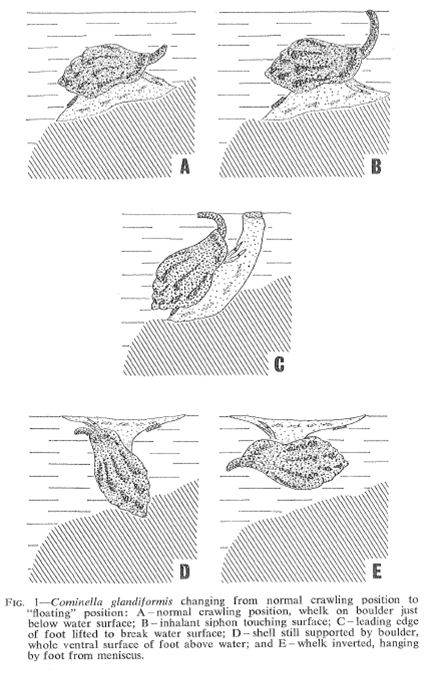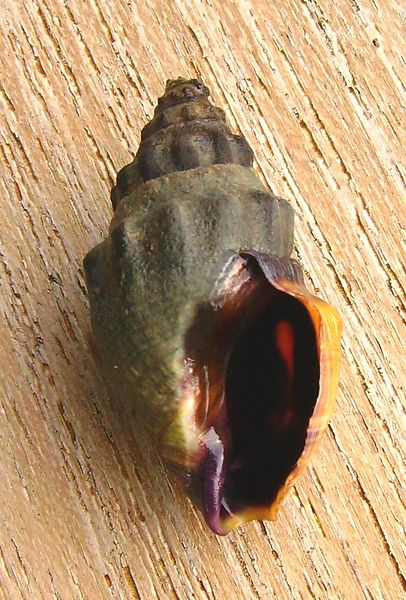 Many year 13 Biology students will spend some time during the school year on a plant or animal study. Often the organisms you’ll study will be something like slaters, or duckweed, because they are easy to keep & study in the classroom. But that’s not always the case, & today I thought I’d write about one such study that was done on a different animal. Let me introduce you to…
Many year 13 Biology students will spend some time during the school year on a plant or animal study. Often the organisms you’ll study will be something like slaters, or duckweed, because they are easy to keep & study in the classroom. But that’s not always the case, & today I thought I’d write about one such study that was done on a different animal. Let me introduce you to…
… Cominella glandiformis, a predatory mudwhelk that’s common on muddy shores & estuaries throughout New Zealand. These little animals – the shell is a couple of centimetres long – have got an amazing sense of smell (taste?). I’ve seen them converge on food (an opened cockle, for example) from several metres away, detecting the water-borne odour with a special sense organ at the base of their siphon. (Click here to see a better image; it’s copyrighted so I haven’t pasted it here.)
Anyway, this particular piece of research (Bimler, 1976) resulted from a chance observation. (And a lot of ‘blue-skies’ science is like that, where a researcher notices something & thinks, I wonder why that is?) The student was out on the local mudflats with her family & noticed some mudwhelks going past – but not in the way you’d expect ie crawling about on the mud. These animals were floating, hanging upside down beneath the water surface, suspended beneath their expanded feet (which were greatly enlarged). And that chance observation was the basis of a 7th-form (look at the date!) bio study, a science fair project, & ultimately a published paper.
This floating behaviour seemed an odd way of getting around (it certainly hadn’t been described before) & the student wondered what had induced it. Her working hypothesis was that the behaviour was related to overcrowding, providing a rapid means of dispersal. To test this she worked out the average density of whelks on the mudflats, then collected a whole lot and set them up in aquaria at home, where she could observe their behaviour & manipulate population densities. (This suggests that her parents were rather understanding, very tolerant, or both! Not least because the experiments ran for 20 days & the tank water, from the local estuary, was changed every 4 days. There must have been a lot of travelling to & fro, at a time when relatively few students had their own cars.)
There were some flaws in this set-up: the salinity of the water used seems on the high side, as do some of the assumptions about overcrowding & oxygenation in the animals’ usual environment – unless they were trapped in pools there should be a regular supply of oxygen, & removal of wastes, as the tides move in & out. And in fact, ideally the tank water would have been changed more regularly, as the student comments in her paper that the water became progressively more murky in between changes. But even so, overcrowding did seem to have some effect on the animals’ behaviour.
In tanks where the number of snails approximated what you’d see in the wild, the animals seemed to behave relatively normally, moving up & down the sides of the tanks in a rhythm that reflected the times of high & low tides out in the estuary. In more crowded tanks this rhythm appeared to break down, & the snails spent more time out of the water. And in the high-density tanks C. glandiformis showed the same floating behaviour that she’d seen that day in the estuary, crawling up on rocks or the sides of the tank, gradually extending & expanding the foot upwards to break the surface, & eventually floating beneath the foot, as shown in the figure below.

And this behaviour was least common on the days when the water was changed, increasing in frequency as the water got more & more polluted with wastes. (In case you’re wondering, the animal seems to expand its foot by channelling more blood into it.) The tentative conclusion: that this behaviour provided a means of dispersal, possibly in response to polluted conditions, although this wasn’t tested in the field.
Not a bad outcome for a year 13 science project 🙂
A.M. Bimler (1976) Effects of overcrowding on floating behaviour in the mud whelk Cominella glandiformis (Mollusca: Gastropoda). New Zealand Journal of Marine & Freshwater Research 10(4) : 715-720
[PS I must confess to a vested interest in this one – because A.M. Bimler was me. And that combination of personal interest with encouragement & support from my parents, teachers, & a scientist who took time to help with the paper itself pretty much set me on the path I’ve followed ever since.]

Lois Rid says:
I enjoyed reading about this behaviour in whelks. Haven’t seen it in whelks in the Chch estuary yet.
Alison Campbell says:
Glad you liked it 🙂 I thoroughly enjoyed doing that little project; that, & actually getting a paper published as a result, while I was an undergraduate student, really cemented my desire to become a scientist. (Shows the value of science fairs, cos that’s what got me into the project in the first place, plus supportive & encouraging teachers & parents – & the scientist who encouraged me to write it up.)